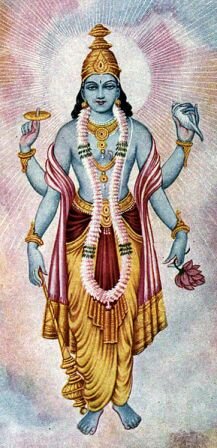One of these following facts about Vishnu should be really interesting for you to read. Vishnu is the Supreme God in Hinduism and especially Vaishnavism, one of three main sects of Hinduism. Vishnu is also known as Narayana and Hari and considered as one of the three main dieties of Hinduism, called Trimurti. The other two being Lord Shiva and Lord Brahma. The Vishnu Sahasranama describes Vishnu as the all-pervading essence of all beings, the master of—and beyond—the past, present and future, the creator and destroyer of all existences, one who supports, preserves, sustains and governs the universe and originates and develops all elements within. To get to know more information about Vishnu, here are some other facts about Vishnu you may be interested in.
Facts about Vishnu 1: Mukunda
Vishnu is also venerated as Mukunda, which means God who is the giver of mukti or moksha (liberation from the cycle of rebirths) to his devotees or the worthy ones who deserve salvation from the material world.
Facts about Vishnu 2: Name
The traditional explanation of the name “Vishnu” involves” the root “vis”, meaning “to settle”, or also “to enter into, to pervade” glossing the name as “the All-Pervading One”.
Facts about Vishnu 3: Self-portrait
In Hindu sacred texts, Vishnu is usually described as having the divine blue color of water-filled clouds and as having four arms. He is depicted as holding a padma (lotus flower) in the lower left hand, a unique type of mace used in warfare known as a Kaumodaki gada in the lower right hand, a Panchajanya shankha (conch) in the upper left hand and a discus weapon Sudarshana Chakra in the in the upper right hand.
Facts about Vishnu 4: Vaishnava Canon
The Vaishnava canon presents Vishnu as the supreme being, rather than another name for the Sun God, who also bore the name Suryanarayana and is considered only as a form of Vishnu.
Facts about Vishnu 5: Interpretative Saga of Vishnu
Curiously, the interpretative saga of Lord Vishnu begins with Lord Shiva. Once when man’s wickedness overran all restraining boundaries, an infuriated Shiva transformed himself into a wrathful form known as Bhairava. Thus converted, Shiva began his rampage of destruction, killing, maiming, and ripping out hearts of humans and drinking blood, his menacing laughter thundering all around.
Facts about Vishnu 6: Defeat of Indra
Following the defeat of Indra and his displacement as the Lord of Heaven or Swarga, Vishnu takes his incarnations or avatars to Earth to save mankind, thus taking the place of the Supreme God, winning recognition by Shaivites ad Smarthas.
Facts about Vishnu 7: Rigveda
In the Rigveda, Vishnu is mentioned 93 times. He is frequently invoked alongside other deities, especially Indra, whom he helps in killing Vrutra and with whom he drinks Soma. His distinguishing characteristic in the Vedas is his association with light.
Facts about Vishnu 8: Key to Indra’s Success
Jan Gonda, the late Indologist, states that Vishnu, although remaining in the background of Indra’s exploits, contributes by his presence, or is key to Indra’s success. Vishnu is more than a mere companion, equal in rank or power to Indra, or sometime the one who made Indra’s success possible.
Facts about Vishnu 9: The Four Arms
The four hands of Vishnu express dominion over the four directions of space. They also symbolize the four stages of human life, known as the four ashrams: 1) The quest for knowledge (Brahamacharya); 2) Family Life (Grihastha); 3) Retreat into the Forest (Vana-Prastha); and 4) Renunciation (Sannyasa).
Facts about Vishnu 10: The Four Aims
The hands further signify the four aims of life (Purusharthas), these are: a) Duty and Virtue (Dharma); b) Material Goods, Wealth, and Success (Artha); c) Pleasure, Sexuality, and Enjoyment (Kama); and d) Liberation (Moksha). Likewise the four arms represent the four castes and the four Vedas.
Hope you would find those Vishnu facts really interesting and useful for your reading.










 www.PortlandPayday.Loans
www.PortlandPayday.Loans